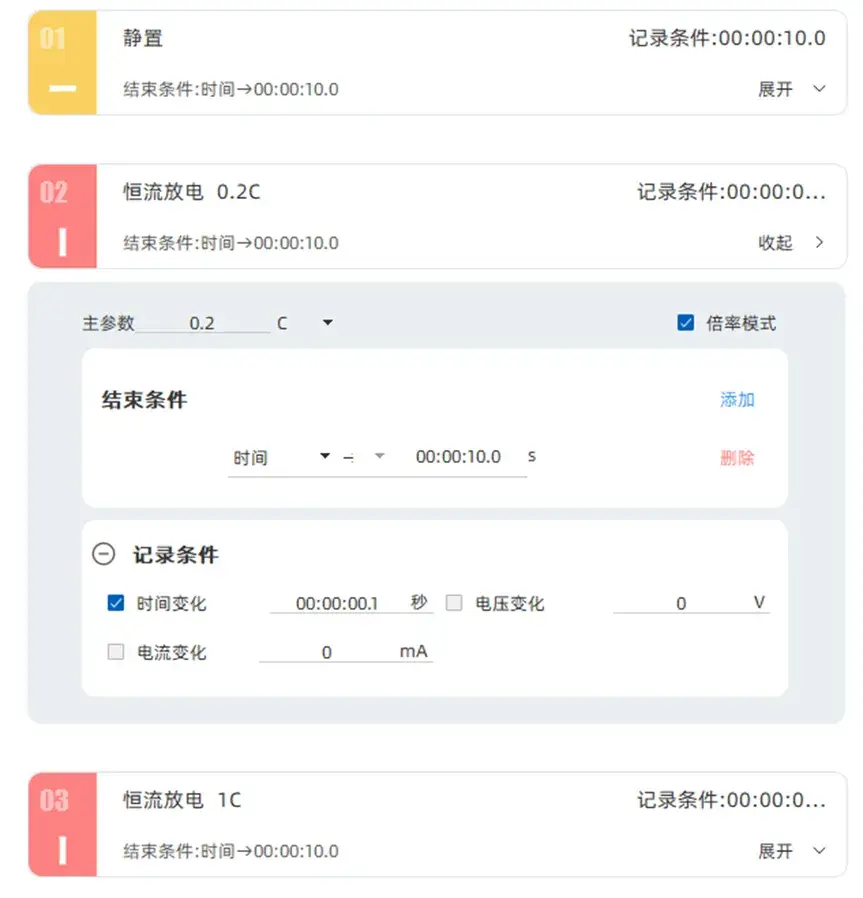-
iestinstrument
Entering Electrochemistry | How to Accurately Measure of Battery Direct Current Internal Resistance(DCIR)
What is DCIR?
Direct Current Internal Resistance (DCIR) refers to the resistance value calculated using Ohm’s Law by applying a direct current step signal to a battery and measuring its voltage change. DCIR represents the total internal impedance of a battery, which includes ohmic resistance and polarization resistance. As a core component of new energy vehicles, energy storage systems, and consumer electronics, battery performance and safety have always been key concerns in the industry. DCIR is one of the most commonly used and intuitive performance parameters in battery testing. It is closely related to a battery’s power characteristics and energy efficiency, and also provides critical references for lifespan prediction and safety assessment.
In this article, we will demonstrate how to perform DCIR testing using IEST’s high-precision charge-discharge equipment in accordance with the IEC61960 international standard, and walk through the actual testing process via software steps.
2. Why is DCIR Testing So Important?
DCIR testing is a core and critical method for evaluating battery performance, state of health (SOH), and safety. Its importance can be understood from the following key aspects:
2.1 Directly Reflects Battery State of Health (SOH)
-
Resistance and aging: During use and aging, the battery’s electrochemical materials and physical structures degrade (e.g., loss of active material, electrolyte decomposition, thickening of the solid electrolyte interphase—SEI). These degradations directly lead to an increase in internal resistance.
-
Quantifying degradation: DCIR provides a quantifiable metric for this degradation. By periodically measuring DCIR and comparing it to the cell’s initial factory value, one can accurately assess SOH and remaining useful life. Larger increases in DCIR generally indicate more severe capacity fade.
2.2 Key Indicator for Evaluating Power Performance
-
Power = Voltage × Current: A battery’s output power depends on its terminal voltage and the current it can deliver.
-
Effect of internal resistance: According to the formula Terminal Voltage = Open Circuit Voltage − Current × Internal Resistance, when a high current (e.g., during acceleration or startup) flows, the internal resistance causes a voltage drop within the battery. A higher internal resistance results in a larger voltage drop, reducing the actual operating voltage.
-
Practical consequences: A lower operating voltage means reduced output power. For electric vehicles, this manifests as weak acceleration and difficulty climbing slopes; for starter batteries, it may fail to start the engine; for drones, it may fail to provide sufficient lift.
2.3 Important safety safeguard
-
Risk of thermal runaway: According to Joule’s Law (Q = I²Rt), current flowing through internal resistance generates heat. A battery with higher internal resistance will produce more heat under the same current.
-
Overheat indicators: An abnormally high internal resistance may indicate internal defects such as micro-shorts, poor connections, or local dry-out. These defect points can become local hotspots during high-current operation, significantly increasing the risk of thermal runaway (fire, explosion). Thus, DCIR testing serves as an effective method for battery safety screening, enabling timely identification of “problem cells.”
2.4 Core parameter for Battery Management System (BMS) algorithms
The BMS is the “brain” of a battery pack, and accurate internal resistance data are foundational to its decision-making:
-
SOC estimation: The BMS estimates state of charge (SOC) based on current and voltage. Without accurate knowledge of internal resistance, it cannot accurately calculate voltage changes due to current, leading to significant SOC estimation errors.
-
Power forecasting: The BMS needs to compute the maximum charge and discharge currents the battery can currently handle (e.g., regenerable and output energy bars on a dashboard). This calculation heavily relies on real-time internal resistance values. Inaccurate internal resistance data may cause the BMS to be overly conservative (limiting performance) or overly aggressive (posing risks).
-
Cell balancing management: A battery pack consists of multiple cells in series, making internal resistance consistency critical. Cells with inconsistent internal resistance generate different heat and voltage during charge-discharge, exacerbating pack imbalance. DCIR testing can screen out cells with abnormal internal resistance, ensuring consistency in pack assembly.
2.5 Benchmark for production efficiency and quality control
DCIR testing is commonly implemented as a 100% inspection item in manufacturing:
-
Process Defect Detection: It quickly identifies manufacturing defects such as poor tab welding, uneven coating, or insufficient electrolyte wetting. These defects directly manifest as abnormal internal resistance.
-
Consistency Screening: Sorting cells with consistent internal resistance is key to assembling high-performance, long-life battery packs. Packs with poor internal resistance consistency will experience rapid performance degradation.
3. Basic Principle of DCIR Measurement
DC internal resistance measurement typically employs the current pulse method. The principle is as follows:
-
Apply a constant current pulse to the battery.
-
Record the instantaneous change in battery voltage.
-
Calculate internal resistance using the formula:
R = ΔV / ΔI
Where:
ΔV = Voltage difference before and after the current pulse
ΔI = Magnitude of the pulse current
The key lies in relying on a high-precision, high-speed sampling system to capture millisecond-level voltage transitions. IEST’s high-precision charge-discharge equipment achieves voltage and current measurement accuracy up to 0.01% and supports 100 Hz high-speed sampling. This enables not only precise control of pulse signals but also efficient and reliable acquisition of critical data.
4. Test Step Configuration
Below illustrates the typical steps our equipment follows when performing IEC61960 DCIR testing:

Figure 1. DCIR Test Steps – IEST ECT & ERT Series Products
4.1 Rest Phase
-
Purpose: Ensure the battery reaches a stable open-circuit voltage (OCV) state.
-
Function: Eliminate electrochemical disturbances from previous operations.
4.2 Constant Current Discharge Pulse (0.2C, 10s)
-
Apply a constant current pulse to the battery for 10 seconds.
-
Record the instantaneous voltage drop and its gradual stabilization.
-
This is the core data source for DCIR calculation.
4.3 Short Pulse Verification (0.2C, 1s)
-
Retest voltage change under a shorter pulse.
-
Used to analyze dynamic response and polarization effects.
-
Helps refine the internal resistance model.

Figure 2. Automatic DCIR Calculation and Export – IEST Analyzer Software
5. Advantages of Our Equipment
Compared to traditional equipment, our system offers superior accuracy, flexibility, and safety:
5.1 High-Precision Sampling
-
Voltage accuracy up to microvolt level, ensuring capture of instantaneous voltage changes.
-
Stable current control for accurate pulse application.
5.2 Flexible Step Design
-
Supports rate modes (e.g., 0.2C, 0.5C), facilitating testing of batteries with different capacities.
-
Users can quickly configure steps based on IEC standards or custom requirements, and save step templates for future use.
5.3 Powerful Data Processing Capability
-
Automatically calculates battery internal resistance, reducing manual analysis errors.
-
Supports data export for further modeling and analysis.
5.4 Compliance with International Standards
-
Fully compatible with battery testing standards such as IEC61960.
-
Suitable for various applications including research, certification, and quality inspection.
5.5 Safety Protection Mechanisms
-
Built-in overvoltage, overcurrent, and overtemperature protection.
-
Ensures dual safety for both equipment and battery during testing.
6. Application Scenarios
Our DCIR testing solutions have been applied in multiple fields:
-
Power Battery R&D: Analyze the impact of different cathode and anode material systems on internal resistance.
-
Production Quality Inspection: Quickly screen cells with abnormal internal resistance to improve consistency.
-
Energy Storage System Validation: Monitor internal resistance changes in large-scale energy storage batteries to prevent failures.
-
Research Experiments: Establish comprehensive electrochemical models by combining with EIS, CV, and other methods.
7. Summary
In simple terms, DCIR is like a “cardiovascular health check” for batteries:
-
The internal resistance value is akin to blood vessel patency (resistance). Low resistance means smooth blood (current) flow and strong pumping capacity of the heart (battery).
-
Changes in internal resistance reflect aging and pathological changes (degradation and defects).
By measuring this metric, doctors (engineers) can assess a person’s physical capacity (power performance), health status (SOH), and risks of stroke or heart attack (safety), and accordingly formulate treatment plans (BMS management strategies).
Therefore, throughout the entire lifecycle of a battery—from R&D and manufacturing to usage and end-of-life recycling—DCIR testing is an indispensable core evaluation method, and its importance is self-evident.
If you are looking for a high-precision battery testing solution, feel free to contact us for more details!
Contact Us
If you are interested in our products and want to know more details, please leave a message here, we will reply you as soon as we can.



